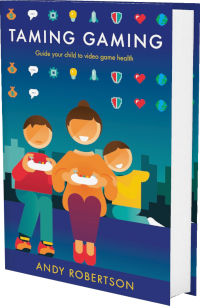 Android
Android iOS
iOS Mac
Mac Switch
Switch Wii
Wii Wii U
Wii U PC
PC PS4
PS4 PS5
PS5 Xbox One
Xbox One Xbox X|S
Xbox X|S20/03/2024 5 weeks ago Author: Andy Robertson
Using video games in education is not a new idea. The opportunity seems clear. On the one hand, teachers work to engage students in learning. On the other hand, children rush to video games for engagement in their free time. Combining the two is a no-brainer, right?
However, finding a way to capitalise on video games without instrumentalizing and undermining the power of the play they offer has been somewhat elusive. Common approaches include using games as a motivating theme for learning that capitalises on the interest of young gamers. Or using video game techniques like high scores and progression to gamify learning and incentivise effort. They have also been used as a reward for work, or possibly as something to do before the learning starts, with a loose connection between the two.
These approaches can offer good results but miss out on the unique educational value of video games as a new medium. They don’t let games do what they do best: invite children into open, creative and engaging spaces and then let them drive the experience. They put video games to work, which turns them into something other than play.
Discovering Hinterland Knowledge
Maybe we are looking at the educational potential of video games all wrong? That’s the realisation I had when reading about hinterland knowledge in Christine Counsell’s blog post. Hinterland knowledge is a phrase she defines as the contextual, cultural understanding required to understand and access the core learning of a lesson.A creative writing task about a trip to the beach is almost impossible if you haven’t had a family holiday at the seaside. An interpretation question about a poem that talks about war photography is impenetrable if you don’t know how photos are produced and published before the smartphone era. These are examples of the hinterland knowledge needed so that you can join the dots that lead to educational sparks and learning.
“We might consider the hinterland to be the rich array of content, stories, and examples that give meaning to the core. Far from the excess and clutter that I thought I had seen in my colleague’s class, the hinterland is the life-sustaining context that feeds the core. The intrigue and significance that lie within those neatly defined propositions.”
It seems to me that video games are an untapped resource of this hinterland knowledge. Much like the overlooked importance of (hinterland) provincial areas, they offer an equalising route to gaining life-sustaining knowledge. While many children won’t have the middle-class dinner-time conversations that build this knowledge, they are willing to spend hours at their screens with interactive games that take them on a similar journey.
Video Games Are Uniquely Primed With Hinterland Knowledge
This potential of video games is untapped for the very reason that this idea sounds mistaken or misguided. The last thing we want to do is encourage children to spend more time gaming, right? Video games are assumed to be about quick reactions, power fantasies and getting children to spend more time and money than they intended. They are about these things, but they are much more about the things that books, films or poetry concern themselves with.There are games like Microsoft Flight Simulator where you can run a control tower in an airport. Or how about designing a new pizza in Good Pizza, Great Pizza? Or maybe taking a trip to the beach as a teenager in Wide Ocean Big Jacket? Or designing eco-cities in Terra Nil? Or even nurturing a rare breed of bees in Apico?
The potential of these experiences is well tailored to developing hinterland knowledge for the precise ways that video games differ from books, films or poetry. Unlike reading about the seaside or watching a film about photography, a video game puts you in the shoes of the experience. You get to feel what it’s like to take the photo, to enter the dark room, to wash the paper in chemicals.
Video games, counterintuitively, are one of the most embodied forms of media we can experience. This makes them primed not only as a vehicle to deliver hinterland knowledge to children in a form that feels like home, but also to do this in a way that grants experience, as well as knowledge.
Capitalising on this potential of course involves much more than pointing out how video games may offer some useful background to other learning. Unlocking these benefits requires that we identify which video games may offer suitable hinterland knowledge to specific subjects. We need to put this to the test by pairing games and learning in ways that support the curriculum.
This could then make it possible for teachers to suggest a whole range of video game experiences that students are unlikely to find themselves, that support the upcoming lessons. The benefit here is that children are motivated to play video games, particularly ones that aren’t designed to teach core knowledge. It introduces new games with hinterland benefits, as well as highlighting the games they already play as a site of learning connected to school.
An Example of Video Games Supporting The Curriculum
John Tomsett offers a brilliantly detailed approach to how hinterland knowledge of photography, photo development, newspaper publishing and war all support the interpretation of the War Photographer poem by Carol Ann Duffy which is a core part of the English curriculum. He brings his own hinterland knowledge to the lesson with pictures, videos, gallery visits, emails and first-hand enthusiasm about photography to support students’ interpretation of the poem.This is an interesting example to test whether video games may have something to contribute. Which video games offer a hinterland understanding of this War Photographer poem.
Playing Season A Letter to the Future, the player is given the experience of being a photographer, journaling the remnants and aftermath of a war. Then there is Lushfoil Photography Sim which invites the player to refine their skills in taking and framing pictures in beautiful landscapes. Umurangi Generation is urban but teaches first-hand about how lenses and exposure work. More tangentially, the game Nuts is a chance to set up cameras to capture the behaviour of wildlife in the night. Or there are games like Once+Again and The+Baby+in+Yellow, that specifically teach about physical film processing, dark rooms and chemicals.
The religious hinterland knowledge that the poem draws upon could also be supported by a range of video games. Indika is a chance to reflect on the clash of religion and the harsh realities of peasant life, whereas Everybody’s Gone to the Rapture sets up an experience of rural England, that is both removed from war but also full of the half-formed ghosts of lives. Additionally, Spec Ops The Line pushes the ethical problems of war further, with its depiction of Napalm that implicates the player in the destruction. You could even go a step further with this Time article about a war photographer who embedded themselves in a video game.
Moving Beyond Sentimental Ideas
This may all sound grandiose, but really it’s a very basic idea. Children are already flocking to video games at home. While they don’t intend to do this for educational purposes, hinterland knowledge is an accurate (albeit slightly derogatory) way to define the collateral learning that is happening here.It’s also a phrase that gives away a sentimental educational bias similar to those we have about video games. In the hands of curriculum experts, hinterland knowledge is lesser and in service of core learning in schools. Similar to how video game play is seen to be lesser than physical play, this makes it hard to see the real benefits that don’t fit the way things used to be.
Hinterland describes “the land behind”, but just like the underestimated importance of a “rural area economically tied to an urban catchment area”, is just as crucial as core learning for life to function. Video games, although also considered to be a distraction, can offer just as much life-giving and essential benefits as other forms of play.
Of course, a child playing the same blockbuster shooting game over and over has a limited amount of this kind of benefit. While repetitive, competitive games offer benefits like teamwork, collaboration, confidence and identity, what’s more useful is children’s enthusiasm for the medium. This primes them to leap from one game to another, each rich in a new hinterland for them to explore, discover and interact with. Provide them with games that support their learning in the upcoming academic year, and they are very likely to dive in and start building the very skills and knowledge we want them to develop.
Video Games Offer Self-Directed Learning
The benefit here is that children can own their learning in a way they don’t often experience elsewhere. It’s an approach that recognises the inherent desire of children to learn, and the work they are doing in their own time at home. This flips John Tomsett’s lesson on its head. Rather than the teacher enthusing about hinterland knowledge from their life, it’s the students who bring passion and first-hand knowledge that drive the lesson forward.Finding which bits of which games do this in a way that specifically links to lessons at school is a powerful way to join the dots between hinterland and core learning (to use curriculum language). It links the work they are doing at home with what is happening in school in a way that opens a back-and-forth between teachers, parents and children that spans the classroom, the living room and the bedroom.
This offers a route into the curriculum for a wide range of pupils who lack the support to gain this hinterland knowledge in other ways. For example, where the home environment is unstable or precarious. Or where parents aren’t available to engage or encourage learning and conversation. This is knowledge that not only scaffolds the core learning but also provides a context that makes sense of why it is being taught.
“A curriculum exists to change the pupil, to give the pupil new power. One acid test for a curriculum is whether it enables lower-attaining or disadvantaged pupils to clamber into the discourse and practices of educated people, so they gain the powers of the powerful.” Christine Counsell
Video games have the potential to play a role in offering a leg up to children otherwise struggling to get a purchase on the discourse. They offer a child-focused route to find enthusiasm and knowledge about subjects that may otherwise seem a bit of a mystery, or aimed at other children who seem to “get it” in a way that eludes them.
Harnessing The Hinterland
It’s been fascinating to see this learning at work in all sorts of projects and contexts. From being a guest in Rachel Higginson’s Finding My Voice sessions, to the lessons I’ve piloted with PSHE Association, it’s clear that children can’t get enough of this kind of learning.It’s also been clear that for this to be effective, they need guidance to the games that match their interests, and passions and tie into what’s happening in the curriculum. The Family Gaming Database I run is a good tool for educators and parents to find games that fit their needs. To take this further, we have collaborated with the Carina fund to provide a page that lists games that offer hinterland knowledge for areas of the mathematics curriculum. Why not go and check it out?
 | Andy Robertson |
References:
- Finding My Voice - Rachel Higginson
- The indirect manifestation of knowledge - Christine Counsell
- Core or Hinterland? Who owns the enacted curriculum? - John Tomsett
- Huh: Curriculum conversations between subject and senior leaders - Mary Myatt and John Tomsett
© 2024 Family Gaming Database












